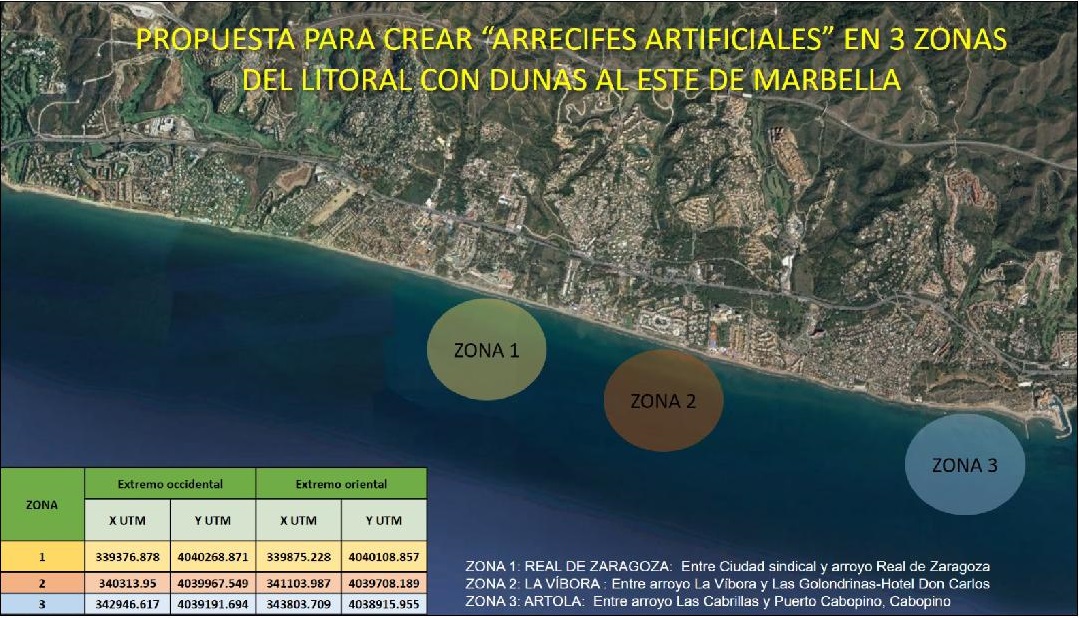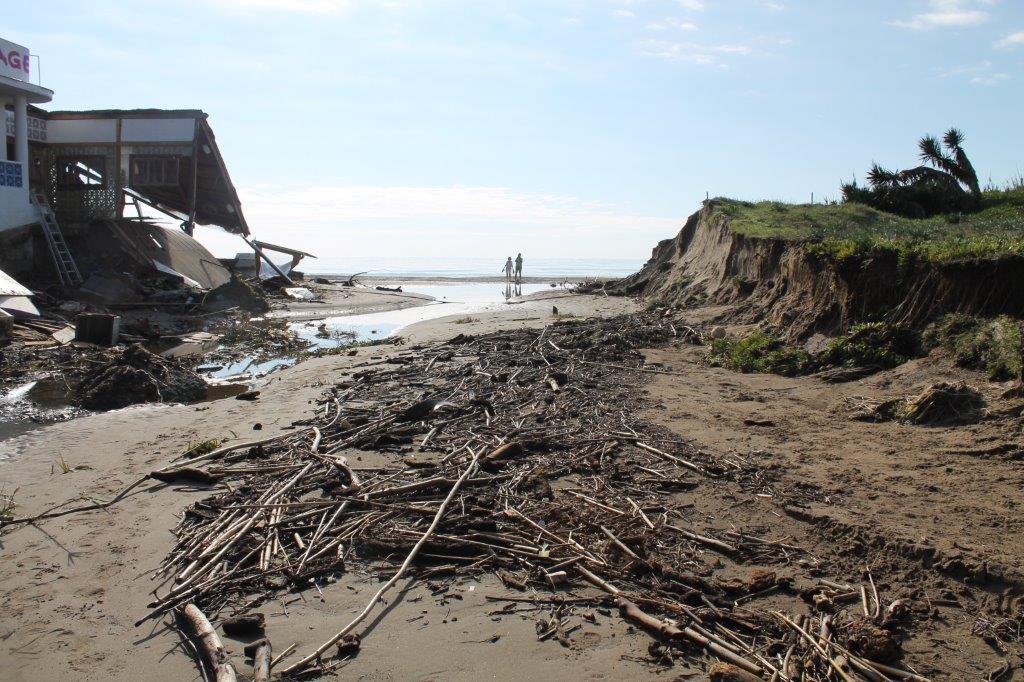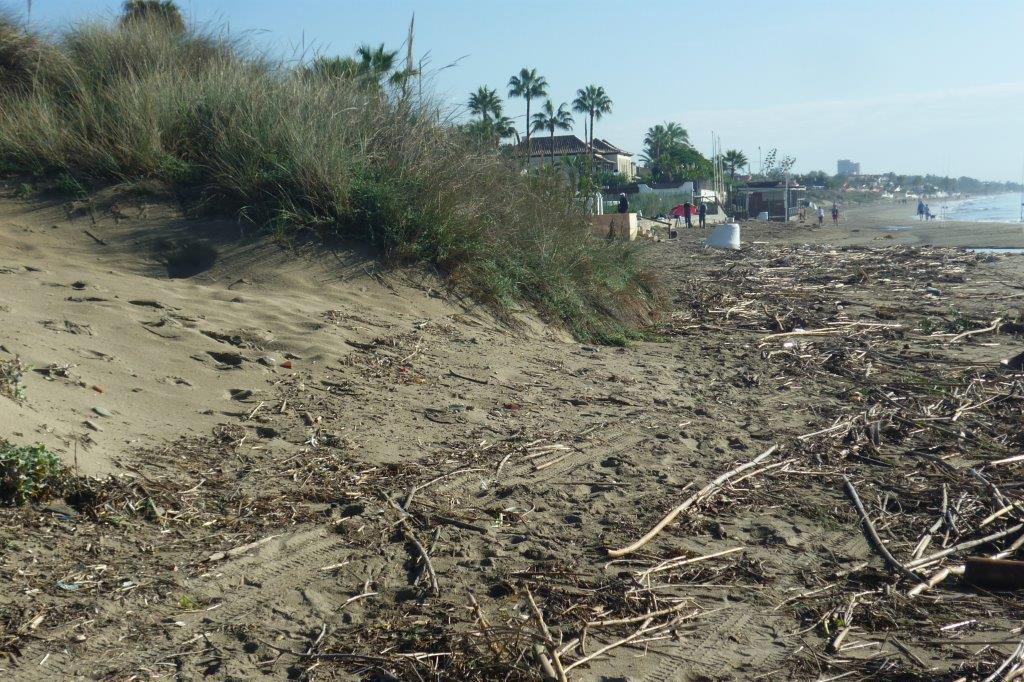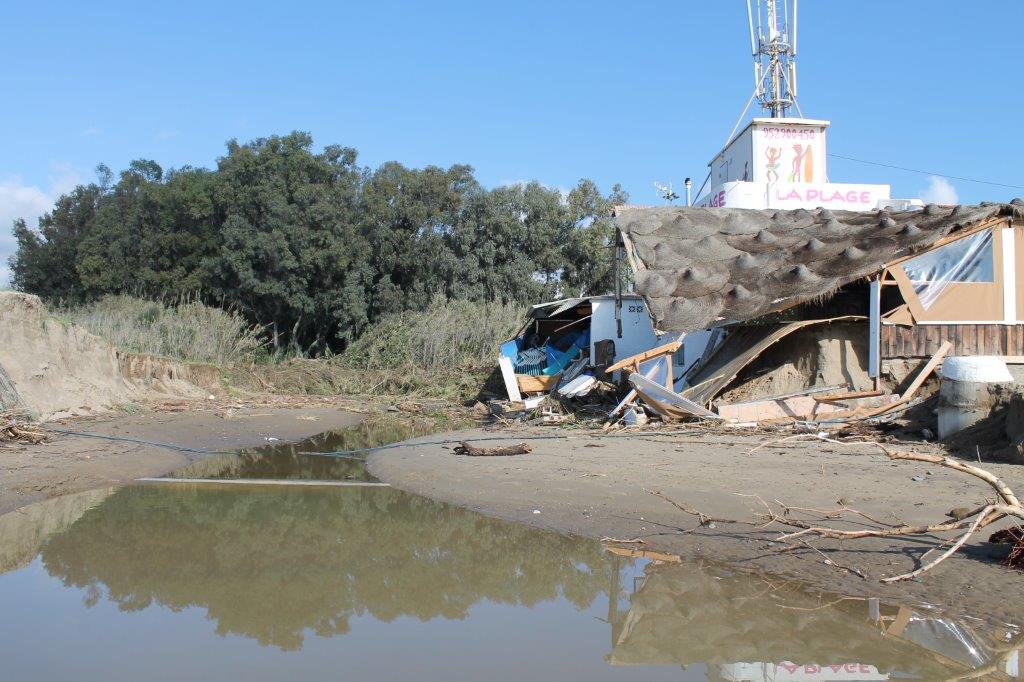NEW PROJECTS
Technical Research Project on the stabilization of the beaches on the dune coast to the east of Marbella by installing multifunctional artificial reefs.
THE CURRENT SITUATION OF THE COASTLINE TO THE EAST OF MARBELLA
At the beginning of December 2016, the first atypical storm hit this coast. The damage it caused to the beaches was of a kind never seen before. In view of the enormous loss in height (up to 2m) and width (up to 7m) of beach and loss of dune mass (up to 3m²), we contacted the Ministry of the Environment in Madrid (Directorate General for the Sustainability of the Coast and the Sea) requesting an urgent meeting. This was held on 13th March, 2017. Four months later, when 5 further storms hit the coast to the east of Marbella, the beaches were so badly affected that it was obvious that urgent action was needed to stabilize them and help dissipate the tremendous harmful energy of the waves BEFORE they hit the beaches.
Never in the 14 years ProDunas has been involved in the protection of the dunes and beaches has the coastal situation to the east of Marbella been in such dire straits. We have learned over time that the dunes play an important role in the balance between beaches and sea. We also have learned to appreciate the dune systems on their own as a valuable landscape that hosts an endless amount of biodiversity.
Without dunes there are no beaches and without beaches there is no tourism – this is the motto ProDunas has coined. This statement has acquired extra force, since the dunes are the great reservoir of sand for the beaches, as was shown during the winter 2016-2017. We continue to insist that many tons, many m³ of sand lie just a few meters off shore on the sea floor. The criterion of ProDunas is that these tons of clean sand should be returned to the coast. Ecologically speaking, we can assert that no marine habitat would be destroyed, since no ecosystem could have been created in the short time involved.
The further difficulty is that the sand masses lying between the sandbars and the beach have formed a consistent, flat surface, which means that the twice daily high tides reach the foot of the adjacent dunes. These tides keep on licking at the dune systems every day, so that dune mass continues to be lost, to a lesser extent, but still lost. This devastating storm phenomenon is new and puzzles some people as it shows no sign of ending. We should point out that on the affected beaches the sand does not dry out at all during the day, so sunbathers cannot find any “dry” beach to lie on. They have no choice but to use hammocks.
The destruction of the line of dunes in the 3 areas where multifunctional artificial reefs are planned for is due in part to people climbing the dunes to sunbathe, which is, of course, detrimental to the survival of the dunes and the dune crests.
Sometimes, in a winter like the one we have just had, we have observed that the reserves of sand stored in the dunes has been drastically reduced. ProDunas has seriously doubts that a natural recovery of both the dunes and the stabilisation of beaches will happen naturally after this enormous devastation and loss of volume in both areas.
We are convinced that all of our attention must be focused on saving these dune systems, so that they can stand up to new attacks by the weather and by climate change whose effects we are now beginning to see. The recovery and restoration of the beaches to create dry sand once again should be the short term aim, especially before any more storms hit us.
The dune systems which currently exist along the coast to the east of Marbella cannot be an everlasting store of sand because they do not have the capacity to recover the mass they have lost. There are areas that if effective action is not taken by replacing sand, by taking back the sand from where it has been dumped just off shore, the beach and dunes will disappear in a few short years, which would cause irreversible damage to the adjoining urbanizations.
Based on this worrying situation, ProDunas’ proposal is to install multifunctional artificial reefs in the 3 coastal dune areas. These measures will provide the necessary coastal and dune protection which will create new ecosystems which, in their turn, will create a new branch of ecotourism – scuba diving.
Our Association stands behind ecological and environmentally friendly measures, a symbiosis between sea and land, such as multifunctional artificial reefs which sustain the local ecosystem. These arguments justify not using submerged and/or visible breakwaters on the dune coastline. Breakwaters completely alter the direction and flow of the currents.
Our Association is getting a professional team together to draw up technical plans for multifunctional artificial reefs. These will be presented to the Ministry of the Environment .The technical studies necessary to get this project started are multiple and will require both quality data (bathymetries, historical records, granulometric studies, diagnoses of the current state …), as well as huge efforts to get the financial support of the Ministry of the Environment and the other Public Administrations which will have to be involved.
OUR PROPOSALS – MULTIFUNCTIONAL ARTIFICIAL REEFS
The effects of climate change can already be observed on the coast of Marbella and although until now there has been no significant change in the height of the waves and the swells, these last storms have contained more energy than any in the past two decades and have had a direct effect on the dune areas.
Although the rise in sea level is not identical all along the coast, a coastal retreat of 10 meters is expected by 2050 in the Marbella area, according to the report entitled “Impact on the Spanish Coast due to the Effect of Climate Change” which was commissioned in 2006 by the Ministry of the Environment from experts in the University of Cantabria. If this were to happen, it would have terrible consequences for the dune systems to the east of Marbella, and by knock on effect, to the beaches.
To study the impact produced by the effects of climate change on the dune systems we have to consider the combined effects of the various elements which contribute to the maritime climate, such as:
1º – A change in wind intensity or a change in the angle of the prevailing wind generates a change in its carrying capacity perpendicular to the orientation of the dune (possible dune erosion).
2º – A change in the height where a wave breaks or a change in its angle generates a change in coastal transport capacity (this can generate dune erosion).
3º – A change in the average level of the sea generates a variation of the mean flow of wave energy and therefore a tilting of the beach (possible increase in the flood levels and beach retreat).
4º – The increase in the height of the swells and in the frequency of the storms generates a greater impact on the coast (which translates into a possible retreat of the beach).
2018 must be the decisive year to get conclusive solutions on the table, to get the approvals necessary to begin the scientific studies and complete all the projects in one year so that the implementation of the multifunctional artificial reefs can get under way.

Do you want to receive our newsletter?
Do you want to become a member or be our friend of the dunes?
The Association works tirelessly for the defence and preservation of the unique ecosystems that survive in the natural sand dune environments in the Province of Málaga; promotes the protection of native flora and small wildlife; promotes recovery, rehabilitation and conservation of interesting biodiversity of sand dunes areas in the municipality of Marbella.
THE ASSOCIATION
THE ECOSYSTEMS
ENVIRONMENTAL EDUCATION










